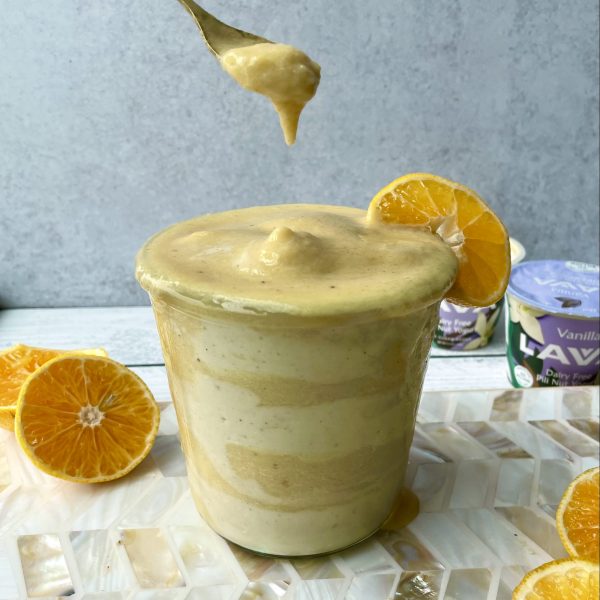A Nutritionist’s Guide to Grocery Shopping
Whether we live for or loathe our weekly trip to the market, we all have to eat. But with endless options on grocery store shelves, figuring out what to buy can feel overwhelming. Below, Lavva’s contributing registered dietitian Anthea Levi, MS, RD, shares what’s inside her grocery cart, plus pro tips for stocking up smart.
Produce
First things first: prioritize produce. Ideally the bulk of our meals (think: ½ our plate) should come from fruits and veggies, so it’s a no-brainer that we’ll fill the majority of our shopping carts with whole foods.
Variety is the key to consuming a well-balanced diet, and since different fruits and veggies offer distinct nutrients, I tell clients to buy at least two produce items each week that they haven’t had in a minute. So, if you typically stick with classics like apples and bananas, branch out and add a kiwi or grapefruit to the mix. Always roasting the same sweet potato and broccoli combo? Go for something seasonal like yellow squash this summer.
I’m also all about making healthy eating easier, so I often opt for shortcuts, like pre-shredded kale or Brussels sprouts, or already peeled garlic cloves to shave time off of dinner prep.
When it comes to my weekly produce staples, I always buy the following:
- Bananas – I eat one almost every morning either with Lavva, on toast with nut butter, mixed into homemade chia pudding, or frozen and blended into a smoothie
- Berries
- Apples
- Baby carrots, mini cucumbers, celery, or bell peppers – These make healthy snacking simple. Dip them in hummus or guacamole.
- Greens – I like to buy a mix of mild and more intense greens. I always get baby spinach for simple salads and to add to green smoothies. I also add heartier greens like kale or Swiss chard to my cart. I love sauteing these with onions and a ton of lemon juice for a nourishing dinner side.
- Avocado – Need I say more?
- Roast-able veggies – Roasted vegetables are on repeat in my house. I love getting veg like sweet potatoes, Brussels sprouts, and cauliflower nice and crispy in the oven.
- Herbs – Herbs like fresh mint or cilantro can make a dish. Buy them weekly to elevate your eats.
- Garlic & onions
- Lemons & limes
Pro tip: If you’re looking to save money, frozen fruits and veggies are just as nutritious as their fresh counterparts. In fact, they can be even more nutrient-dense since they’re harvested and frozen at their peak. Fresh foods, on the other hand, can start to lose nutrients on their lengthy journey to the grocery store.
Proteins
Including adequate protein in the diet is key for maintaining muscle mass, supporting immune function, and keeping us satiated. At home, I tend to focus on lean proteins like eggs, seafood, lean ground turkey, and tons of legumes. Since seafood can get pricey, I’m all about tinned fish like sardines, which are packed with hard-to-find dietary vitamin D, as well as anti-inflammatory omega-3 fatty acids.
Pro tip: If you consume animal products, aim to eat fish three to four times a week to get the optimal health benefits from seafood. For those who are canned tuna lovers, go for skipjack tuna (the variety is lowest in mercury) and keep your tuna intake to a max of once weekly.
Healthy Fats
Don’t fear fat. The filling macronutrient is a secret weapon for everything from improved heart health to fewer cravings. Just make sure you’re opting for nourishing sources of fat, like nuts and nut butters, seeds, avocado, fish, and anti-inflammatory oils like olive and avocado oil.
Another favorite source of fat? Lavva’s unique base: pili nuts. High in healthy fats and low in carbs, pili nuts lend Lavva’s products an ultra creamy texture that can help keep you full for a whole lot longer than a 0% alternative.
I never fail to buy Lavva’s Chocolate Plant Milk, which I’ll foam and add to my morning coffee or use as the base of a smoothie. Lavva’s Vanilla Yogurt is another go-to for me. I like throwing in some hemp seeds, fresh fruit, and a sprinkle of crunchy granola for a delicious start to the day.
Pro tip: Warm up a cup of Lavva’s Chocolate Plant Milk before bed to wind down for the evening. It’s the ultimate grown-up hot chocolate — sans the sugar crash.
Carbs
This just in: carbs are not, in fact, the enemy. Our bodies require glucose, the breakdown product of carbohydrates, for fundamental fuel. Yes, fruits and vegetables are technically carbs, but it’s a-ok to incorporate starches like whole grains and bread, as well.
Here are some options I love:
- Sprouted whole wheat bread or wraps – High in gut-friendly fiber
- Potatoes
- Corn tortillas – Look for a brand that makes its product solely from non-GMO corn, lime juice, and water
- Whole grains – Brown rice, quinoa, farro, and organic oats are all solid picks
- Legume-based noodles, like chickpea or black bean pasta
Pro tip: Contrary to popular belief, all types of potatoes offer important antioxidants. White potatoes provide an impressive amount of vitamin C, while sweets serve up beta-carotene. You’ll also get fiber from both thanks to their skin. Try roasting a Japanese sweet potato (AKA satsumaimo) with cinnamon and topping it with a drizzle of drippy tahini. It’s the dreamiest.
Extras
I’m a sucker for fun products, so you’ll usually find at least one new-to-me product in my shopping cart, like the matcha green tea noodles and pineapple Spindrift pictured above.
Something sweet is also a non-negotiable in my weekly grocery haul. I always have goods on hand for refined sugar-free treats (like medjool dates stuffed with mixed nut butter and a bit of sea salt), but you’ll find some brownie fudge ice cream in my freezer too. After all, balance is best.






